 Armchair Genealogy
Armchair Genealogy
By
Melinda Cohenour
A Much Maligned Man: Sidney Washington Creek
Born: 13 January 1832 in Liberty, Clay County, Missouri
Died: 12 September 1892 in Liberty, Clay County, Missouri
Chapter 4 in the Life of the Much Maligned Man
In August of 1862, Missouri was fully embroiled in the violence and unrest that had fomented the great and horrible Civil War that would result in the greatest loss of life yet seen by Americans in any armed conflict. Within the borders of Missouri and its neighboring state of Kansas, factions were sharply divided and loyalties split between the abolitionist views and the established lifestyles of the Southern pioneers. Missouri’s Governor in 1861 was Claiborne Jackson, a neutralist who discouraged enlistment of Missourians to Federal service. In June of 1861 Federal authorities supported the formation of Unionist Home Guard regiments Federally controlled; however, these units were largely disbanded by the end of 1861 and replaced by six-month service state controlled militia whose responsibilities were severely limited and loosely managed. By January of 1862, these units had also disbanded and been replaced by the Missouri State Militia, a force of mostly cavalry units still state controlled.
As discussed in the previous installment of Sid Creek’s story, the Red Legs of Kansas continued to organize deadly thieving raids across the border of Northwestern Missouri. Almost all the hale and hearty men folk were either engaged by the Confederate Army or had enlisted as Union soldiers, leaving the farms and homesteads occupied only by women, children and elderly men vulnerable to attack and destruction. Those young men left behind oftimes joined with guerilla forces to protect their homesteads and remaining family from those vicious attacks.
Following the disastrous Battle of Pea Ridge, Confederate forces had withdrawn from Northern Arkansas and flooded into Missouri to recruit those loyal to the Southern cause. The success of this recruiting effort, coupled with the failed state militia efforts to date, resulted in Confederate Jefferson Davis choosing to legitimize the burgeoning guerilla bands by encouraging them to “follow the rules of war” and later be folded into the Confederate Army. This was not acceptable, of course, to the Union Army and Brigadier General John Schofield would respond by issuing Order No. 18 to the Missouri State Militia which read, in part, "When caught in arms, engaged in their unlawful warfare, they will be shot down upon the spot." (SOURCE: https://en.wikipedia.org/wiki/Enrolled_Missouri_Militia )
This Order, though strongly worded, had little effect given the dwindling forces of the Missouri
State Militia and the success of the Confederate recruitment efforts. In a move to counter these issues, on 22 July 1862 Schofield, aided by the provisional Governor, Hamilton Rowan Gamble (who had served 4 Mar 1822 as circuit attorney in the trial where Sidney’s grandfather, Abraham Creek, served as a juror), issued an order requiring compulsory enrollment.
General Order No. 19 requiring loyal men to enroll in the militia, required registration of all who had previously taken up arms against the United States, and for them to surrender their weapons. The disloyal and Confederate sympathizers would not be required to enroll in the militia, but would have to declare their sympathies, which many were unwilling to do and instead enrolled.
On 12 April 1862, Sidney Washington Creek, under duress, signed the Oath of allegiance before Col. M. B. Pennick, Liberty Missouri Command Post and gave bond.
1862-4-12 - Sidney Creek sworn oath to Pennick certificate |
.jpg)
|
His allegiance, however, was definitely to the cause of the Confederacy. As subsequent tightening of restrictions against Southern sympathizers began to be exerted, Sid chose to make plans to protect his family and serve according to his conscience. In early August of 1862, he delivered his wife (Lucinda) and children (Georgia, Charles, Emma, Lamira, and Beau) to the estate of his father-in-law, Henry H. Estes. Estes would later, in a deposition prompted by the forfeiture of Sid’s allegiance bond, state that he urged Sid to stay and not give up his bond by leaving. Sid stated fervently that he “valued his life more than property” and was “going to the bush.” Later that same month, Sid was sworn into the Confederate service at Jackson, Missouri, enlisting for “three years or the war” and was assigned to the Confederate 9th Regiment, Missouri Cavalry, Company B (Elliott’s battalion, Capt. Walton’s company).
The morning of 8 January 1863, would find Sid marching with the Confederate troops assigned to Col. Joseph Orville Shelby on the outskirts of Springfield, Missouri. The mission was to augment the two regiments marching in under Brig Gen. John S. Marmaduke who was driving forces up from Pocahontas and Lewisburg, Arkansas, into the area where the Union forces per scout reports had been weakened. In this series of skirmishes, Sid would bear arms. Timing became a critical factor for the rebel troops, as columns commanded by Col. Joseph C. Porter and Col. Emmett MacDonald failed to arrive in time to make a coordinated pincer attack against the embedded Union troops. Ultimately, the Confederate troops were forced to withdraw, suffering losses greater than those of their Union counterparts.
Immediately following Marmaduke’s retreat from Springfield, his troops met up with Col. Porter. They engaged Union forces over three days (January 9 to 11, 1863) at Hartville, Missouri. As part of Col. Ben Elliott’s 1st Bttn., Missouri Cavalry, under command of Col. J. O. Shelby, Sidney Creek was assigned to picket duty. This consisted of a fixed position scouting operation where the advance location of the pickets could relay word of opposing forces’ movements to their commanders, thus, directing the most opportune strategic moves for the troops. This three-day operation resulted in mixed successes. The Union forces were disrupted, forced to abandon some key positions and permitted Marmaduke to set up a field hospital for a time; however, the resultant loss of several Confederate leaders (among them Brigade Commander Porter and Col. MacDonald) dealt a serious blow to the Confederate troops.
This is a charcoal sketch done by Anna Lee (Dillenbeck) Stacey.
Charcoal portrait of General Joseph Orville Shelby in suit coat, vest, shirt, and tie.
The drawing is signed by the artist. Below the signature,
"Genl. Jos. Orvill Shelby" is written in different hand
From State of Missouri website Archives covering the Civil War.
|
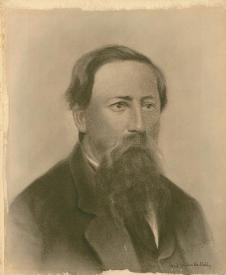
|
Following the days long skirmishes at Hartville, Missouri, Marmaduke marched his troops back south to Arkansas. Sid, as part of Col. Shelby’s command, was encamped south of the White River at the farm of Franklin Desha. It was bitterly cold. Union Col. George Waring, 4th Missouri Cavalry, along with his 600 troops was given permission to engage the Confederate forces at Batesville, Arkansas. It is reported that a CSA scout who rushed to Marmaduke to warn of the impending foray was disbelieved. (Your author, given knowledge of Sidney Creek’s canny abilities, recent duties as an advance scout, and family lore that he served as a spy for the rebels, wonders if this scout was, indeed, our Sid.) At any rate, many of the rebel troops managed to move by ferry across the White River ahead of Waring’s approach. Knowing he was badly outnumbered by the troops under Marmaduke’s command, Waring employed a few slick tricks to delude his enemy as to the size of his own command. He ordered small groups to deploy over a wide area, setting up fake campfires to indicate a wide-ranging group of men. He also employed misinformation techniques by use of the local rumor mill, dropping hints that his was merely a small detachment of a much larger force soon to arrive. This strategy served to deter Marmaduke from crossing back over the river and engaging the much smaller force with his some 3,000 plus soldiers. Early the following morning, 4 February 1863; however, Shelby gave chase.
The Encyclopedia of Arkansas History and Culture (website) reports:encyclopediaofarkansas.net/encyclopedia/entry-detail.aspx?entryID=6690
The Union troops wasted no time packing and preparing to move at dawn; as Waring reported: “We levied such contributions of supplies as were necessary for our return march, and, in order that the return might not look like a retreat, we loaded two wagons with hogsheads of sugar, which would be welcome in Davidson’s commissariat.” Local resident Emily Weaver noted, “Towards day-break, the whole command moved swiftly north, and a few hours later, Gen. Shelby crossed the river with about three thousand men, and followed them a short distance.”
Waring led his men, their prisoners, and their supplies as rapidly as possible through the snow back north. One historian summarized the end of the story succinctly. “The command then marched to Evening Shade, Arkansas, twenty-five miles north of Batesville, where Waring paroled and released most of his badly frostbitten prisoners.”
That February of 1863, Sidney Washington Creek became one of Gen. Waring’s unfortunate prisoners of war.
He was captured, and detailed to care for the sick and wounded.
The bitter cold, lack of food, exhaustion and ragged clothing had taken its toll.
Within a few days, Waring paroled his prisoners, partly to avoid having to care for them as well as his own troops. |
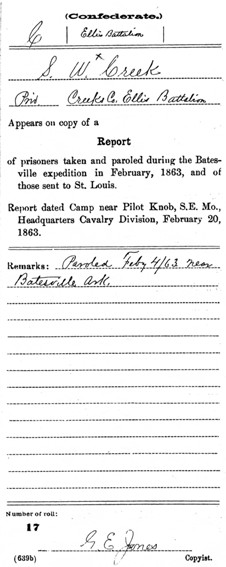
|
Sid managed to find a sympathetic farmer who permitted him to stay there, work the farm, rest up, heal and recover sufficiently to start for home as soon as the weather broke. Spring finally brought warmth for travel and on 20 May 1863, Sid set off, finally, for his home. On 31st May 1863, Cyrus Peroman, a private with the EMM, spotted him in Johnson County, Missouri. Sid was behind enemy lines, dressed in the uniform of a Union soldier. He gave his name as Peter West, but was soon identified as one Sidney Washington Creek, Confederate Spy.
Sidney Creek alias Peter West. |
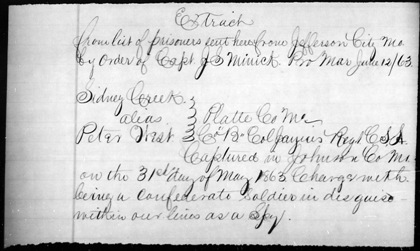
|
Although your author believes the Provost Marshal General took the statement of one “Peter West” extensive searching has only turned up the cover used for the evidentiary file. We do, however, have the statement provided under the true name of Sidney Creek:
“I was taken prisoner by Col. Warren’s (*) forces near Batesville, Ark. about 6th day of Feb’y 1863, & was paroled. I remained in Arkansas from that time (working on a farm) until about May 20th 1863 when I started for my home in Clay Co. Mo. I was making my way through Johnson Co. when arrested. I got the Federal Clothing I had on when arrested from a Confederate Soldier who was arrested & paroled at the same time I was, & who afterwards died. I think he got them at Springfield. I have no leave of absence or furlough, but was coming home intending to deliver myself up to the Federal authorities for trial for breaking my oath & bond. I was run off from home at the time of the enrollment of the EMM, because I would not join the loyal EMM. I was a Southern man and did not want to do it.”
(*) Sidney incorrectly gives the name of “Col. Warren” rather than the actual name of GEN. WARING, whose troops actually captured him and who provided paroles for all captured prisoners shortly thereafter as shown above. The prisoner he refers to, one Peter West, was reported as “slightly wounded” in the battle of Springfield, Mo. on 8 January 1863 and is not known to have died. Several of Sid’s responses were designed to obfuscate the truth and provide protection to his fellow comrades in arms in the Confederate cause. He avoids indicating that he had any military duty associated with his capture by Waring’s troops, as well. Probably because he was acting as a spy or, at minimum, a scout for Shelby. (As an interesting aside here, the officer to whom his statement was made was none other than Samuel Swinfin Burdett, lawyer, later Congressman from Missouri, who would become the Commander in Chief of the Grand Army of the Republic 1885-1886.)
Hon. S. S. Burdett was a member of the First Iowa Cavalry; served, during the war of the rebellion, as Provost Marshal General, with headquarters at St. Louis, Mo.; was afterward Member of Congress for two terms from Missouri; also, was Commissioner of the General Land Office, which he resigned, and is now practicing his profession in Washington City.
SOURCE: The History of Clinton County, Iowa: Containing a History of the County, Its Cities, Towns & Biographical Sketches of Citizens, January 1, 1879, Western Historical Company, publisher.
Portrait created 1 Jan 1880 by L. Weiser,
National Portrait Gallery
Samuel Swinfin Burdett
|
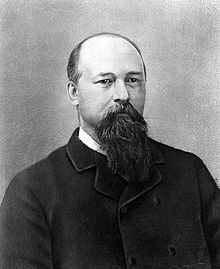
|
Following his capture in Johnson County, Sid was under intense scrutiny. His true identity was discovered and depositions taken to confirm not only his identity, but his allegiance to the “Southern” cause, and his “disloyalty” which would result in the forfeiture of his loyalty bond in the amount of $1,500 (a large sum of money in 1863!) Those deposed to establish his identity were a childhood friend, William Doniphan, and his father-in-law, Henry Harris Estes. Additionally, one Robert W. Fleming, a 2d Lieut. in 4th Pro Reg’t with ties to Clay County, Missouri, wrote a venomous letter suggesting Sidney Creek deserved no less than death as punishment! His claim, undoubtedly, referred back to the 1860 incident involving the killing of Bernard Mosby in an altercation with Sid over lumber. No charges were filed; it being assumed the authorities investigating the matter deemed it a matter of self-defense. Bernard Mosby was first cousin to John Singleton Mosby, known more famously as The Gray Ghost during the Civil War for his daring exploits and flamboyant attire. Given Fleming’s Union affiliation and unyielding devotion to its cause, it must be assumed his outrage was vented to Sid as a “bushwhacker” and not related to any partiality to the Mosby family known for its devotion to the Confederate cause. Our appreciation for Fleming’s letter lies only in the fact that he supplies the one description of Sid Creek that exists beyond the family lore: a “stout man with black eyes” and “when dressed up, is a good looking man.” No photo of Sid has surfaced but his sister, Virginia Adolphus Creek, described him as being very tall, a fiercely loyal man, “a brave and wonderful person,” devoted to the protection of his family and his homeland.
The other part of Fleming’s letter that may provide valuable information, if accurate, is that Sid served with Gen. Sterling “Pap” Price’s Army (actually a state militia) before giving bond in April of 1862. That would place Sid alongside Old Pap Price’s forces as they challenged pro-Union forces attempting to oust sitting Governor Claiborne Jackson. That time frame would have been from April 1861 through about August of 1861 when Price’s troops were forced southward into Arkansas, leaving Missouri a majority pro-Union state for most of the War. Fleming states Sid returned and “joined the Bushwhackers.” Records show he actually enlisted in the C.S.A. in August of 1862, so any time served alongside his kinfolk with Quantrill’s Raiders would have been brief, although more than one publication lists his name as one of Quantrill’s men.
Robert W Fleming Letter of 16 Jun 1863. |
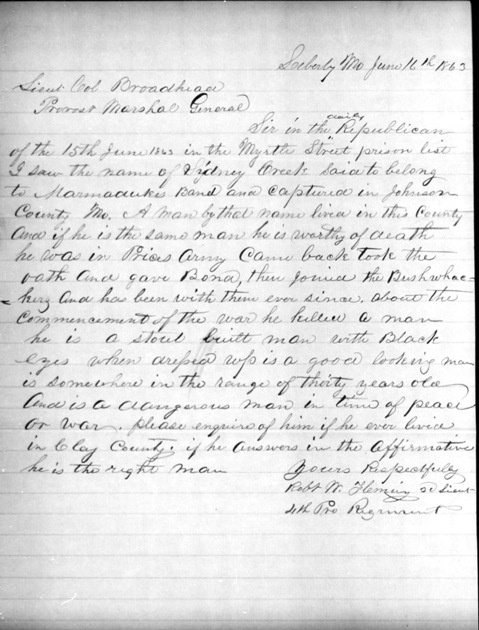
|
After his arrest 31 May 1863, Sid was remanded to Warrensburg where he was held for some 10 days during which time evidence was collected to enforce the forfeiture of his bond. By 13 Jun 1863, Sid had been transferred to Gratiot (pronounced “grass-shut”) Street Military Prison in St. Louis, Missouri, where on the 15th of June he was examined by S. S. Burdett, Acting Provost Marshal General where he gave the statement previously referenced. He was held at Gratiot along with a variety of inmates: citizens who were arrested for “hallooing for Jefferson Davis” or being drunk or disorderly, gunrunners, bootleggers who served liquor to slaves, Confederate prisoners, spies and those suspected of disloyal actions or treasonous statements. Formerly the McDowell Medical College, Gratiot was a large, multi-story, rambling building including a dank and dreary basement. Its transmogrification to a prison was prompted by the over crowding of nearby Myrtle Street Prison and the impending influx of thousands more prisoners. The unique mix of inmates made for an unruly situation with occasional escapes effected without much apparent effort. It was a miserable place to be although its inmates were spared the horrific conditions experienced by many in other prison camps such as Andersonville.
Absalom Grimes, who spent the majority of 1864 in these rooms, said, “In those stirring war days no man was of importance or standing until he had been locked up in Gratiot Street prison at least a few days… The citizens referred to would be rounded up about town and locked up without charges, apology, or explanation and after being boarded for from one week to two months they would be called before the provost marshal and presented with the oath of allegiance to the United States, which they had to sign without question, no matter how great the effort.” |
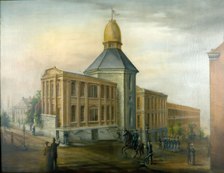
|
Gratiot Street Military Prison - St. Louis Mo. 1861-1864
It was in this prison Sid would linger while the wheels of “justice” ground along. On 30 July 1863, the formalities were dispensed with and the formal Forfeiture of Bond occurred:
“Sidney Creek, Pvt. – Cpt. Walton’s Co., Elliott’s Bn. – Clav. Mo. Vol., St. Lewis (sic) “being a Confederate soldier in disguise within our lines as a spy” has forfeited his bond to the U.S. Government.
This was soon followed by the report on 8 August 1863 that “after arrest on the 12th day of April 1862 Sidney Creek gave $1,500 for ‘future loyalty’ and received a parole to the limits of the said Clay Co.” Things were beginning to wind down. August 12, 1863, the official action to forfeit the bond was taken by U S Attorney Richard A. Barrett. This having been accomplished, Sid’s parole was soon thereafter effected. (SOURCE: "Confiscated and Contraband Property - Richard A. Barrett, Aug.8, 1863” paper.)
|
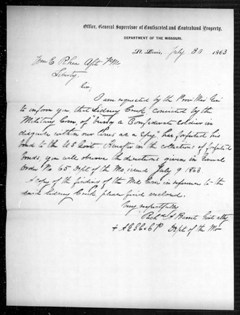
|
On 26 August 1863, Sidney Washington Creek was paroled from the Gratiot Street Military Prison. He would once again begin the arduous trek home from St. Louis to the Northwestern edge of the state. No more materials have been located which would indicate Sid returned to action of any kind in the “War of the Rebellion.” All indications are that he returned to his home, reunited with his wife and family and undertook the task of rebuilding a life on the farm. He and Lucinda would add to their family with the birth of Susan Ludicia 25 May 1865, followed in fairly short order by Lucinda Agnes in 1868, Virginia Darlisco (known affectionately as Jennie) in 1869, Sarah Lee in 1872 and, finally, little Lillie in 1873.
The final chapter in the life of Sidney Washington Creek will be published in the September issue of PencilStubs. For many folks, a simple recitation of the date and cause of death will suffice – perhaps, even the location where their final remains lie at rest. But not for our Sid. His was a life filled from start to finish with drama. That dramatic ending to his life comes next month. Stay tuned.
Click on author's byline for bio and list of other works published by Pencil Stubs Online.
|



.jpg)







